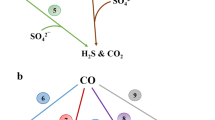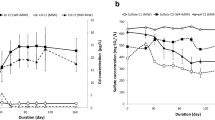Abstract
The production of acid mine drainage (AMD) containing high amounts of sulfate, heavy metals and low pH is of increasing concern. AMD is highly corrosive and results in economic and environmental problems. Organic electron donors for sulfate reduction were chemically characterised for potential use in AMD treatment. This was done in a process to develop a correlation between chemical composition and the capacity to drive sulfate reduction. Potential organic electron donors for sulfate reduction were chemically characterised in terms of dry matter content, ash content, total Kjeldahl nitrogen, lignin content, cellulose content, crude fat, crude fibre, in vitro digestibility, water-soluble carbohydrates, total non-structural carbohydrates and starch content. The chemical composition of the organic electron donors was then compared to results obtained from pilot plant studies where the organic electron donors for sulfate reduction were evaluated in terms of sulfate reduction. The chemical composition of the carbon source severely impacted its capacity to drive sulfate reduction and may be used to assist in predicting the sulfate reduction capacity of a carbon source. Organic electron donors for sulfate reduction high in protein content and low in lignin content or high in carbohydrate and crude fat content increased the capacity of a carbon source to drive sulfate reduction. The higher the fibre content of a carbon source, the lower the capacity to drive sulfate reduction. No correlation could be drawn between % dry matter, % ash content and sulfate reduction for the organic electron donors tested. Chemical characterisation can be used to assist in predicting sulfate reduction capacity of organic electron donors.
Similar content being viewed by others
References
AOAC (1984) Official Methods of Analysis, 14th edn. Association of Official Analytical Chemists Inc., Arlington, Virginia, USA
JL Barry, C Hoebler, S Macferlane, JC Mathers, KA Reed, PB Mortensen, I Nordgaard, IR Rowland and CJ Rumney, Estimation of the fermentability of dietary fibber in vitro: an European interlaboratory study. Brit. J. Nutr. 74 (1995) 303-322
WB Betts, RK Bart, AS Ball and SL Pedlar, Biosynthesis and structure of lignin. In: W.B. Betts (ed.) Biodegradation: Natural and Synthetic Materials. New York: Springer-Verlag (1991) pp.
S Chang, PK Shin and BH Kim, Biological treatment of acid mine drainage under sulfate-reducing conditions with solid waste materials as substrate. Water Res. 34 (2000) 1269-1277
B Christensen, M Laake and T Lien, Treatment of acid mine water by sulfate-reducing bacteria; Results from a bench scale experiment. Water Res. 30 (1996) 1617-1624
Coetser SE (2003) Microbial sulfate reduction in passive acid mine drainage treatment systems. Ph.D. Thesis, University of Pretoria, Pretoria, South Afica
LA Deobald and DL Crawford, Lignocellulose biodegradation. In: CJ Hurst, GR Knudsen, LD Stetzenbach and MV Walter (eds.) Manual of Environmental Microbiology. Washington DC USA: ASM Press (1997) pp.
S Dill L Du Preez M J Graff Maree 1994 Biological removal of sulfate from industrial effluents using producer gas as energy source 5th International Mine Congress Nottingham (UK)
Doelle HW (1975) Bacterial Metabolism, 2nd edn. Academic Press New York
Eger P (1991) The use of sulfate reduction to remove metals from acid mine drainage. Appl. Environ. Microbiol. 51(5): 1289--1307
CS Evans, MV Dutton, F Guillén and RG Veness, Enzymes and small molecular mass agents involved with lignocellulose degradation. FEMS Microbiol. Rev. 33 (1994) 235-240
GJ Faichvey and GA White, Methods for the analyses of feeds eaten by ruminants. Melbourne Australia: CSIRO (1983).
D Feng, C Aldrich and H Tan, Treatment of acid mine water by use of heavy metal precipitation and ion exchange. Miner. Eng. 13 (2000) 623-642
GR Gibson, Physiology and ecology of the sulfate reducing bacteria. J. Appl. Bacteriol. 69 (1990) 769-797
Harris LE (1990) Nutrition research techniques for domestic wild animals, Volume 1
EA Howard, JE Emerick and TR Wildeman, The design, construction and initial operation of a research site for␣passive␣mine drainage treatment in Idaho Springs, Colorado. In: DA Hammer (ed.) Constructed Wetlands for wastewater Treatment. Ann Arbor MI: Lewis Publishers (1989) pp. 761-764
LW Hulshoff Pol, PNL Lens, J Weijma and AJM Stams, New developments in reactor and process technology for sulfate reduction. Water Sci. Technol. 44 (2001) 67-76
EN Kaufman, MH Little and PT Selvaraj, Recycling of FGD gypsum to calcium carbonate and elemental sulfur using mixed sulfate-reducing bacteria with sewage digest as a carbon source Journal of Chemical. Technol. Biotechnol. 66 (1996) 365-374
U Krishnamoorthy, H Steingass and KH Menke, Preliminary observations on the relationship between gas production and microbial protein synthesis in vitro. Arch. Anim. Nutr. 41 (1991) 521-526
YV Kuzyakov, The role of amino acids and nucleic bases in turnover of nitrogen and carbon in soil humic fractions. Eur. J. Soil Sci. 48 (1997) 121-130
Lorax Environmental (2003). International network for acid prevention -- Treatment of sulfate in mine effluents
JP Maree and WF Strydom, Biological sulfate removal in an upflow packed bed reactor. Water Res. 19 (1985) 1101-1106
Malberbe S (2000) Biological Sulphate reduction using lignocellulose hydrolysis by-products produced by fungal hydrolysis of cenchrus ciliaris cv. Molopo (Buffelsgrass). M.Sc. Thesis, University of Pretoria, Pretoria, South Afica
S Malherbe and TE Cloete, Lignocellulose biodegradation: Fundamentals and applications. Rev. Environ. Sci. Biotechnol. 1 (2002) 105-114
HJ Nanninga and JC Gottschal, Anaerobic purification of waste water from a potato-starch producing factory. Water Res. 20 (1986) 97-103
Obarsky BJ, Cirello J & Roy AR (1984) Sulfur removal of polysulfide rubber manufacturing wastewaters by anaerobic treatment. Proceedings of Industrial Waste Conference, pp␣402--408
JA Oleskiewicz BL Hilton 1986 Anaerobic treatment of high sulfate wastes Can. J. Civil Eng. 423 428
VCC passive treatment studies. South Africa: Pulles Howard and de Lange Inc (1999).
Pipes Jr., WO (1960) Sludge digestion by sulfate reducing bacteria. Proceedings of Industrial Waste Conference, Purdue University West Lafayette, pp 308--319
Pulles W, Rose P, Coetser L & Heath R (2003) Development of Integrated Passive Water Treatment Systems for the Treatment of Mine Waters. Proceedings of ICARD Conference, 12--18 July 2003, Cairns, Australia
Pulles W, Coetser L, Heath R & Muhlbauer R (2004) Development of high-rate passive sulphate reduction technology for mine waters. Proceedings of IMWA Conference, 19--23 September 2004, University of Newcastle, UK
Rabenhorst MC, James BR & Shaw JN (1992) Evaluation of potential wetland substrates for optimizing reduction Paper presented at the 1992 National Meeting of the American Society for Surface Mining and Reclamation, Duluth, Minnesota, June14--18
K Rampersad, LA Goldstone and GN Tivchev, Study of methods for the cultivation of anaerobic cellulose-degrading bacteria. Water SA 24 (1998) 343-346
JMA Tilley and RA Terry, A two-stage technique for the in vitro digestion of forage crops. J. Brit. Grassland. Soc. 18 (1963) 104
JH Tuttle, PR Dugan, CB MacMillan and CI Randles, Microbial dissimilatory sulfur cycle in acid mine water. J. Bacteriol. 17 (1969) 594-602
PJ Soest Van, JB Robertson and BA Lewis, Methods for dietary fiber, neutral detergent fiber and non-starch polysaccharides in relation to animal nutrition. J. Dairy Sci. 74 (1991) 3583-3597
Waksman SA (1952) Principles of soil Microbiology, 2nd edn. Williams and Wilkins Co., Baltimore
RK Weider, A survey of constructed wetlands for acid coal mine drainage treatment in the Eastern US. Wetlands 9 (1989) 299-314
Acknowledgements
The financial support of the South African Department of Arts, Culture, Science and Technology’s Innovation Fund programme is acknowledged.
Author information
Authors and Affiliations
Corresponding author
Rights and permissions
About this article
Cite this article
Coetser, S.E., Pulles, W., Heath, R.G.M. et al. Chemical Characterisation of Organic Electron Donors For Sulfate Reduction For Potential Use in Acid Mine Drainage Treatment. Biodegradation 17, 67–77 (2006). https://doi.org/10.1007/s10532-005-7567-3
Accepted:
Published:
Issue Date:
DOI: https://doi.org/10.1007/s10532-005-7567-3




